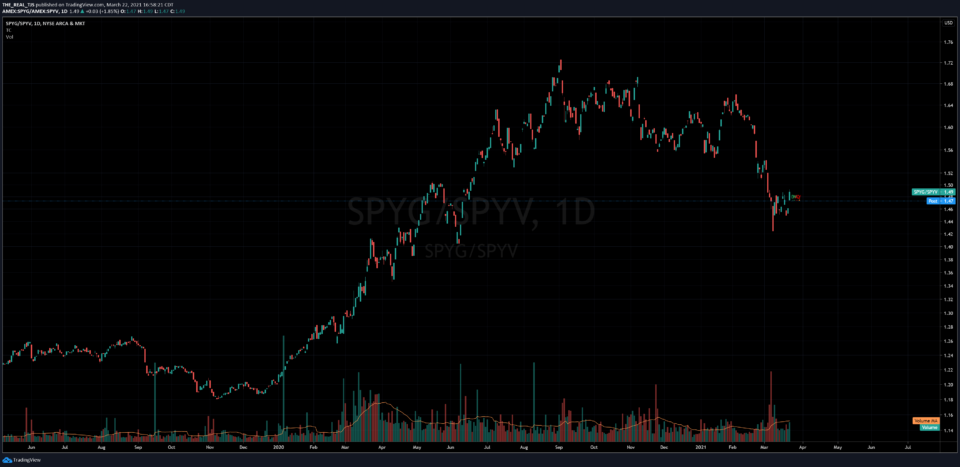Since as of late, so much emphasis has been put on the market’s rotation out of growth stocks and into value, I wanted to put together a series on growth stock investing. What it is, why it may or may not be right for you, and what one is to expect from this particular style or investment strategy. Much of what follows comes from over 100 years of research from William J. O’Neil and company, with some added research from yours truly.
To start, it might be helpful to agree on a definition of what growth investing is, or maybe worded differently, what it is not. Growth investing is not putting money to work in companies which make up the old guard of American brands. Coke, Pepsi, Proctor and Gamble, and Johnson and Johnson may be considered examples. While these are great American companies, they have matured to within their full potential. They likely offer strong dividends and a mature “caretaker management.” They lack new and innovative products, and often have low price to earnings multiples (P/E). That is not to say that investing in these companies is a bad thing, not at all. They reward stability, and pay those who invest handsome dividends which can be counted on. They are a staple in many portfolios and rightfully so, but they are not growth stocks and probably won’t ever be.
So what is a growth stock? A growth stock is one in which shows a major percentage increase in current and recent earnings per share (EPS), strong sales growth, and a high return on equity (ROE). Quite often these a newer companies with innovative products and a management that seeks to change the future. Areas which come to mind presently are genomics, biosciences, edge cloud computing, and streaming media content. They are the companies that may become the next Amazons, Apples, or Gamestops. (kidding on that last one) They are growing, and they are growing fast. Should they execute on their ultimate goals, those who own their shares will be rewarded on the magnitude of 10s, 100s, or even 1000s of times of those who invest in their value or cyclical counterparts.
Sounds great right? I would agree, in fact it is how I personally invest quite literally all of my money. Yes, all of it. I have 0% allocation in fixed income, and almost none in cyclical / value stocks with the exception of a few swing trades generally done via option contracts several months out. Should my cyclical bets work out, the proceeds get invested right back into, you guessed it, growth stocks. But there is a catch… this style of investing is not for the faint of heart, the risk adverse, or the person not willing to sit through uncomfortable periods of short term underperformance.
A quick illustration is warranted of what I mean. This is a ratio chart of growth/value:

You can see that over the past year, growth led the market out of a sharp downturn. Starting in late summer however, growth overall began to stall, giving way to more of the value or cyclical names – what the financial media now refers to “reopening stocks.” Those invested in growth have seen their accounts drawdown, and have been left wondering if this style has fallen by the wayside.
While it’s true the events over the past year have been incredibly unique, this is following a roadmap that has been laid out time and time again over the past 100 plus years.
What is a normal stock market cycle? O’Neil writes that in the beginning phase of a new bull market cycle (like the one which began last year at this time after a sharp short term bear market), growth stocks are nearly always the first to lead and make new price highs. Cyclical stocks like steel and chemical companies, autos and machinery usually lag in a new bull market cycle. Then the emphasis changes. While cyclicals take their turn (and this is a good thing for overall market breadth), this is often shorter lived than a growth stock cycle. Why? Cyclicals fail to represent America’s true future. In addition, the sheer size of these companies makes it difficult to stay nimble, innovate, and compete with America’s newest innovators and young entrepreneurs. At the first sign of an economic slowdown, cyclicals can falter leaving investors with paltry gains that didn’t come close to those gained via growth companies.
Over the 100+ years of research done by O’Neil and company, 4/5 of the biggest winners were growth names. One was a value or cyclical name. This doesn’t mean that value always outperforms growth in the near term. It doesn’t mean that there won’t be shaky periods that entice you to sell growth names and rotate into what’s working now. It doesn’t mean sitting through prolonged drawdowns will be easy. It might however mean that it will be worth it if your goal is to make the most money you can via compound annual growth. Making the most money isn’t everyone’s goal and shouldn’t be. It is however my goal and I accept the risks and discomfort involved in such an endeavor.
In the next installment, I am going to go over characteristics present in the best performing stocks in recent memory. These datapoints have forecasted winners such as 700% share price growth from 1963-1966, 11,200% growth from 1977-1990… They are worth searching for and what I spend my days and nights seeking.
Talk soon.
Trent J. Smalley, CMT
Have a portfolio in need of attention or want to know more? Visit us at JSPMLLC / MyPortfolioFix
Please remember that past performance may not be indicative of future results. Different types of
investments involve varying degrees of risk, and there can be no assurance that the future performance
of any specific investment, investment strategy, or product made reference to directly or indirectly in this
newsletter (article), will be profitable, equal any corresponding indicated historical performance level(s),
or be suitable for your portfolio. Due to various factors, including changing market conditions, the content
may no longer be reflective of current opinions or positions. Moreover, you should not assume that any
discussion or information contained in this newsletter (article) serves as the receipt of, or as a substitute
for, personalized investment advice from JSPM LLC. To the extent that a reader has any
questions regarding the applicability of any specific issue discussed above to his/her individual situation,
he/she is encouraged to consult with the professional advisor of his/her choosing. A copy of our current
written disclosure statement discussing our advisory services and fees is available for review upon review.
